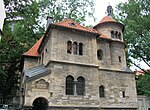Museum of Decorative Arts in Prague

Founded in 1885, the Prague Museum of Decorative Arts (Czech: Uměleckoprůmyslové muzeum v Praze or UPM) is housed in a Neo-Renaissance edifice built from 1897 to 1899 after the designs of architect Josef Schulz. It opened in 1900 with exhibitions on the first floor. The Museum's rich collections include decorative and applied arts and design work ranging from Late Antiquity to the present day with focus on European objects, particularly arts and crafts created in the Bohemian lands. The impressive interior of the permanent exhibition, “Stories of Materials,” offers visitors an excursion into the history and development of decorative arts in the disciplines of glass, ceramics, graphic art, design, metal, wood and other materials, as well as objects such as jewellery, clocks and watches, textiles, fashion, toys and furniture.
Excerpt from the Wikipedia article Museum of Decorative Arts in Prague (License: CC BY-SA 3.0, Authors, Images).Museum of Decorative Arts in Prague
17. listopadu, Prague Jewish quarter
Geographical coordinates (GPS) Address Website External links Nearby Places Show on map
Geographical coordinates (GPS)
| Latitude | Longitude |
|---|---|
| N 50.089722222222 ° | E 14.416388888889 ° |
Address
Uměleckoprůmyslové muzeum v Praze
17. listopadu
116 93 Prague, Jewish quarter
Prague, Czechia
Open on Google Maps











